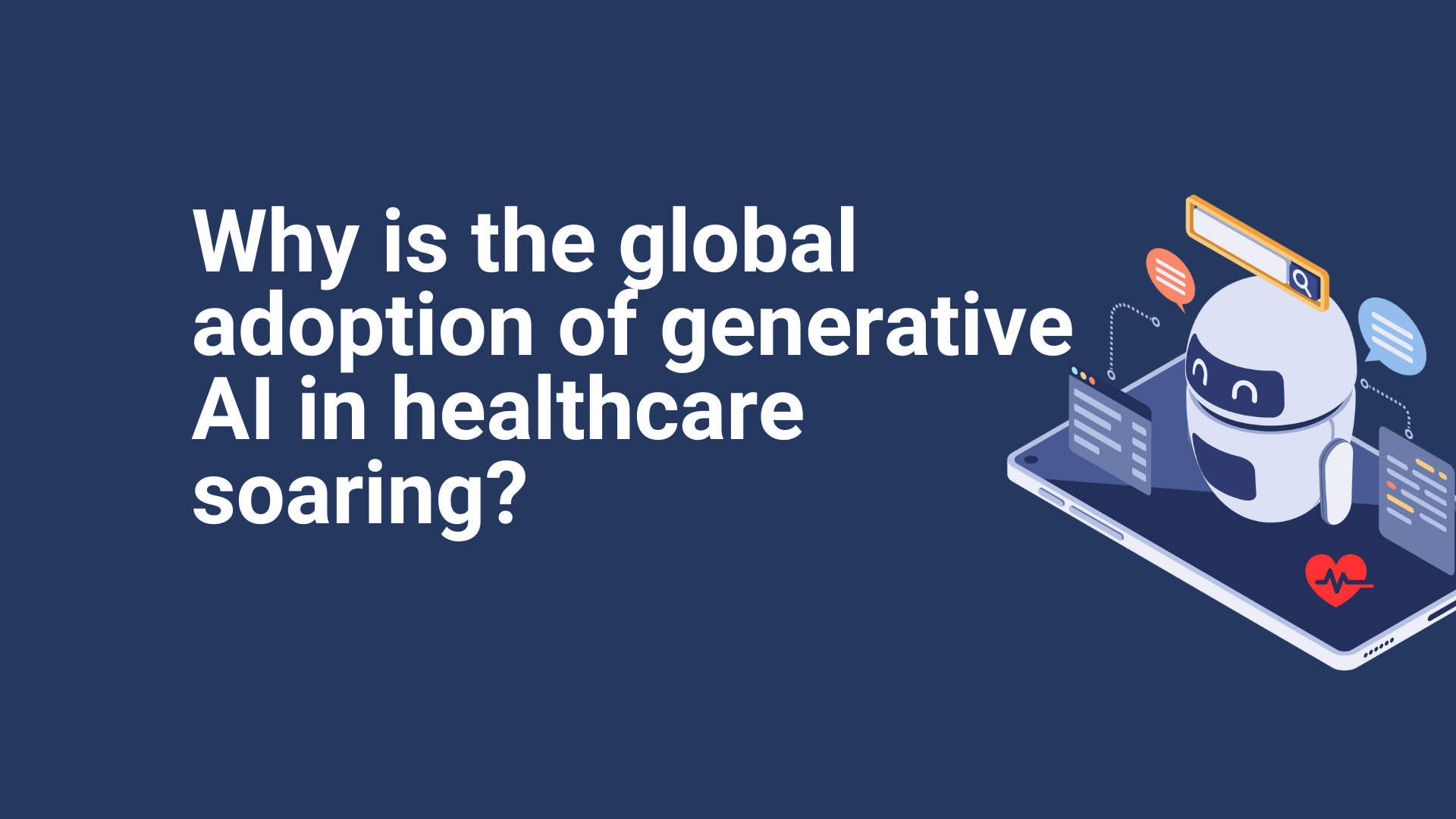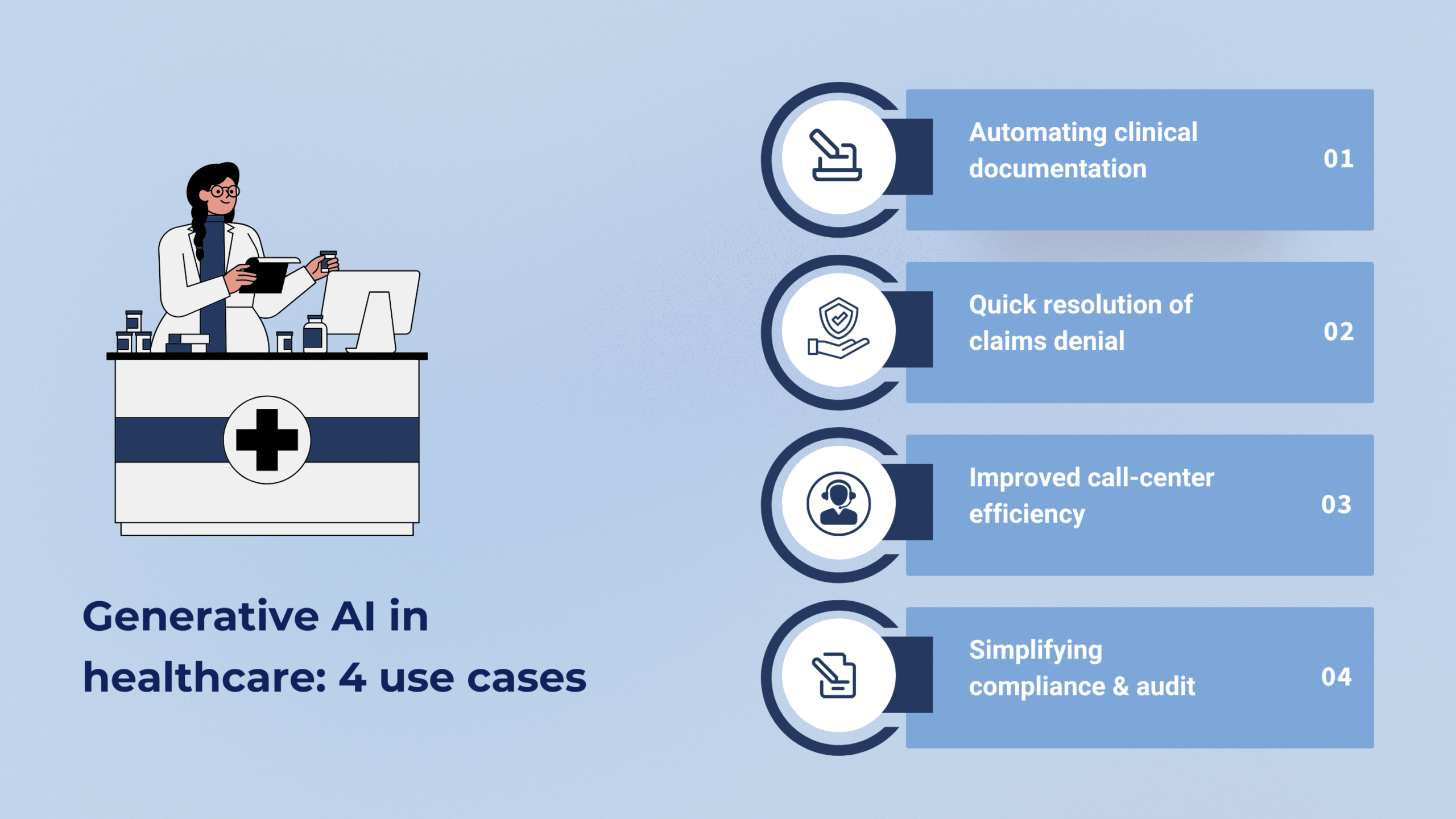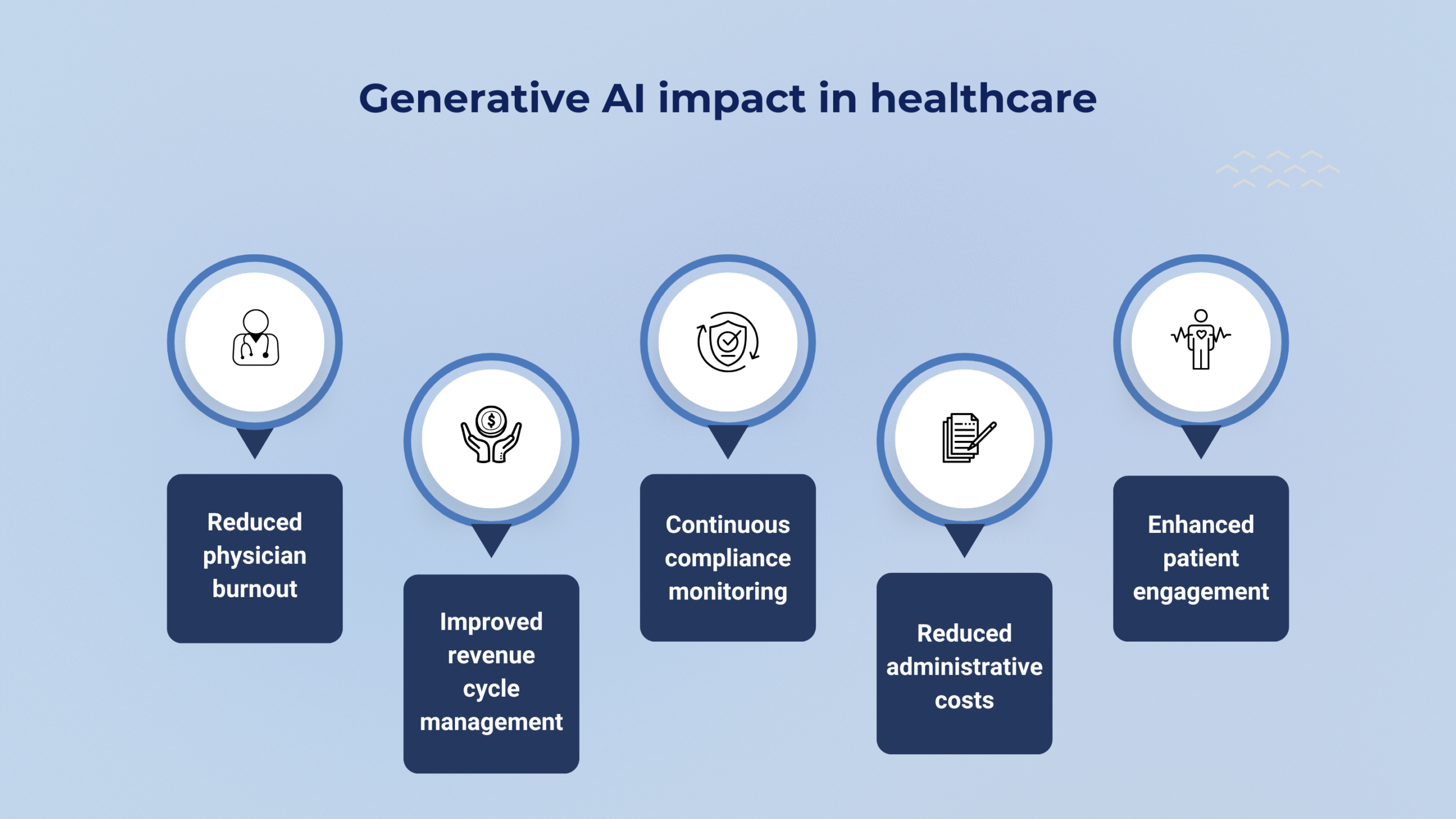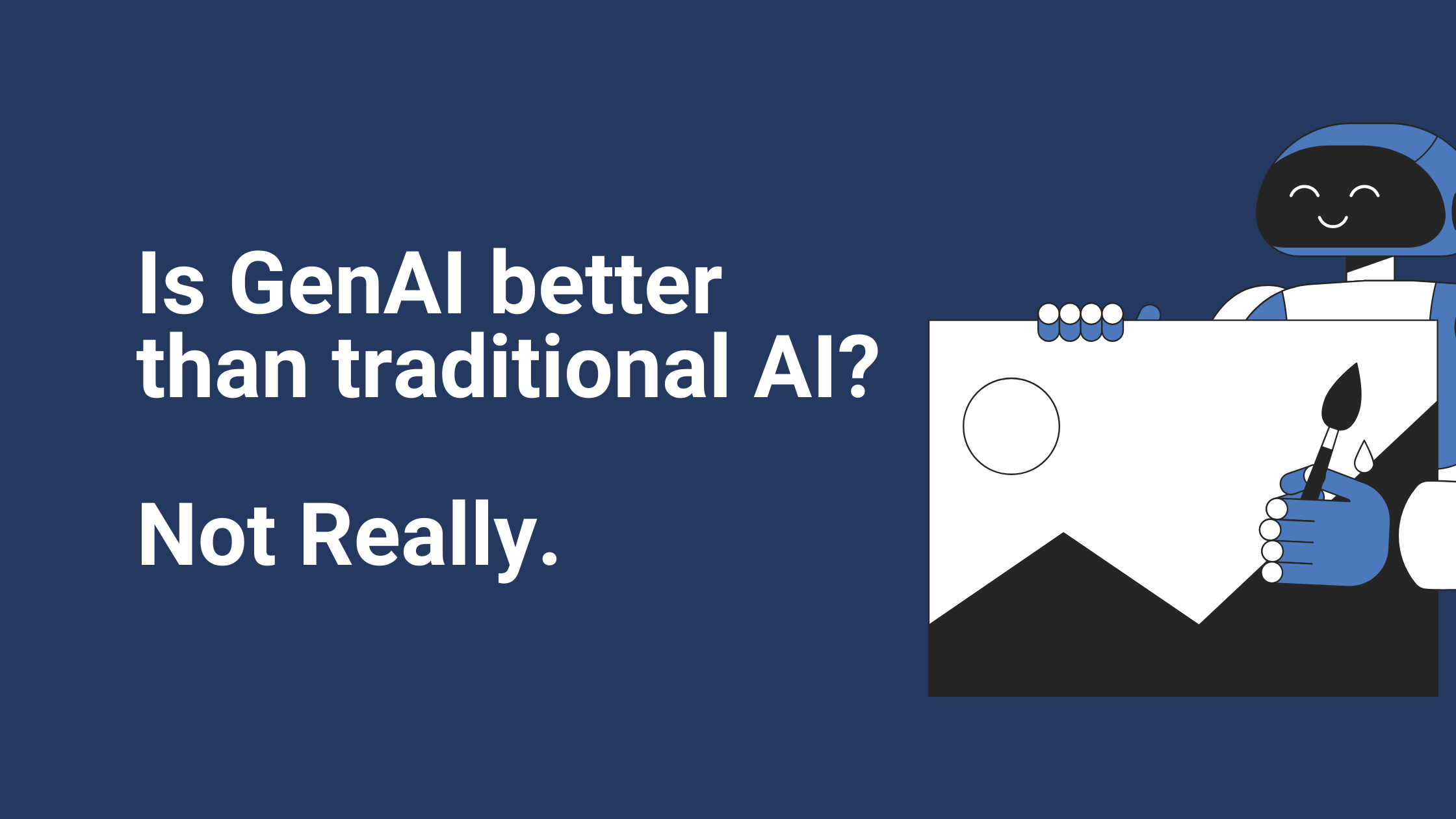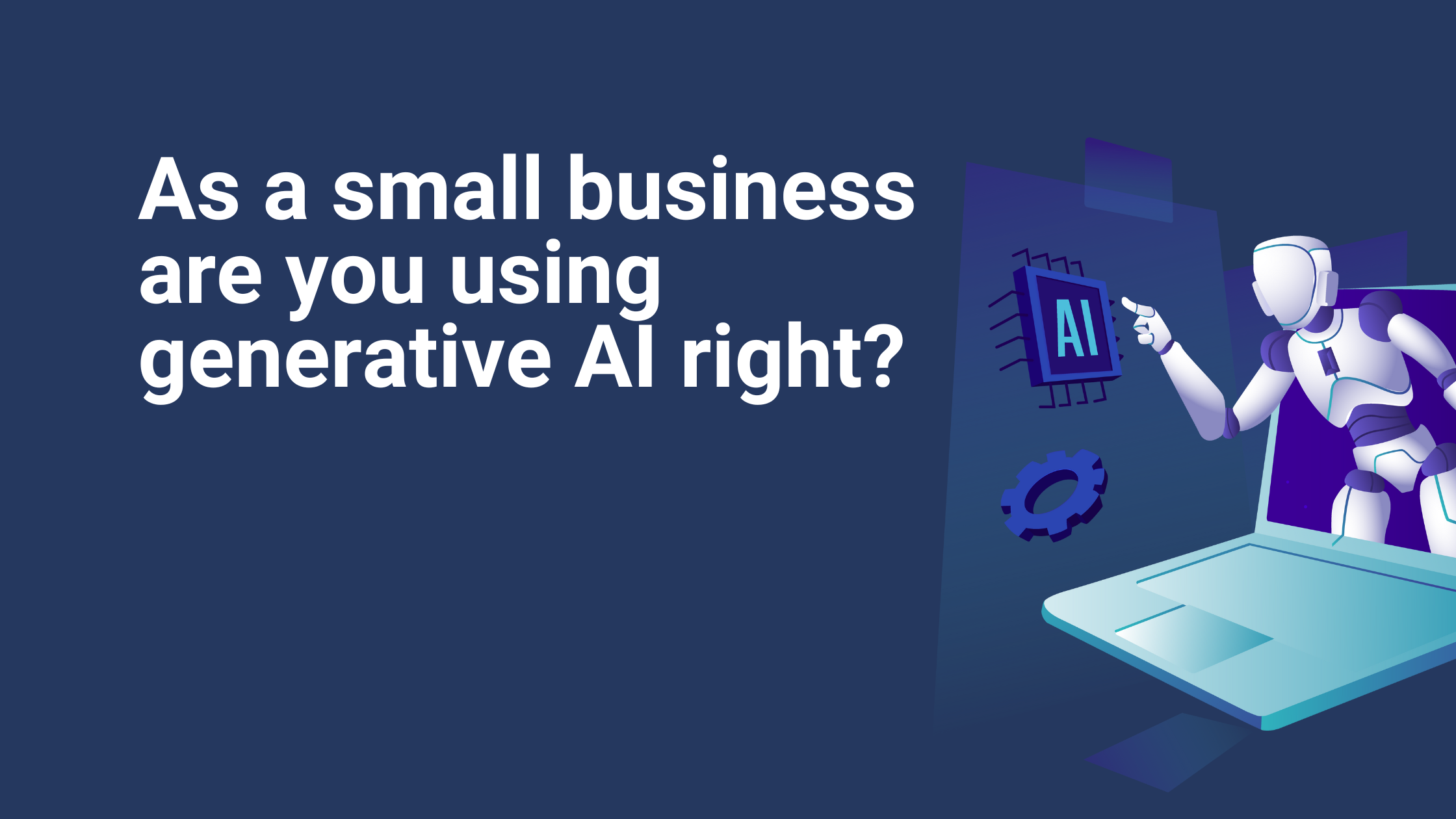How to Leverage Generative AI in Healthcare in 2025
Generative AI in healthcare is fast emerging as the wonder drug for the US’s mounting workforce crisis. According to the American Hospital Association, by 2028, there will be a deficit of around 100,000 critical healthcare workers, including a severe shortage of nursing assistants. It’s not just staff shortages; generative AI in healthcare might also solve the problem of chronic burnout among healthcare professionals. Currently, healthcare workers across the globe are severely beaten, spending long hours on paperwork, which takes away valuable time from patient care.
That could be why several prominent healthcare organizations are actively running POCs and using generative AI to automate manual, repetitive tasks such as documentation, billing, and patient data management.
In this blog, we will examine generative AI in healthcare, its impact, applicable use cases, and disadvantages.
What is generative AI in healthcare?
Generative AI in healthcare is a technology that uses large language models (LLMs) and generative adversarial networks (GANs) to process large amounts of data and create new content based on specific instructions. For instance, LLMs are trained on clinical notes, medical images, audio transcripts, and research documents to produce new information. The outcome is as follows.
- Summarizing patient data quickly and effectively.
- Creating discharge notes, referral letters, or training material.
- Generating precise data for research, education, and validation.
- Real-time diagnostics assistance using contextual clinical information.
Generative AI is especially valuable in healthcare, which is a data-driven sector. According to research by the World Economic Forum, hospitals produce 50 petabytes of data per year, but 97% of it goes unused. Why? It’s mainly because most information, such as clinical notes, lab tests, pathology reports, genomics, and operational and financial data, is unstructured yet highly valuable.
In addition, medical knowledge doubles every 73 days. Generative AI models understand, produce, and contextualize unstructured data into clear, actionable content. Healthcare workers can save up to 20 hours during the work week by offloading administrative duties to generative AI.
Generative AI in healthcare: 4 simple case studies
Generative AI is reimagining healthcare, particularly in administrative and insurance domains. Let’s examine four simple case studies to identify some key challenges that generative AI can solve in healthcare.
1. Automating clinical documentation
One of the biggest challenges contributing to clinician burnout is documentation. Now, healthcare organizations can integrate generative AI-powered tools into their EHR (electronic health record) system. Using speech-to-text conversion, generative AI can capture patient conversations to guide SOP, follow-up care instructions, manuals, etc.
While generative AI handles 90% of documentation, clinicians review and edit as needed, increasing clinician satisfaction and patient throughput.
2. Resolution of claims denial
Health insurance providers have an average of a 15% claims denial rate annually due to incomplete documentation or data discrepancies. Moreover, resolving this problem is slow as analysts must manually review every denial and fill in the incomplete documentation from multiple disintegrated systems.
Generative AI can easily read denial codes, cross-reference EHRs, billing systems, and policy guidelines, and automatically appeal for missing documentation. As a result, analysts can shift their focus from manual processing to complex dispute cases.
3. Improved call-center efficiency
Healthcare call center agents put their patients on long call holds because they must manually search dozens of health plans, benefits documents, and regulatory files. This often leads to manual errors and agent dissatisfaction.
Generative AI healthcare assistants can instantly retrieve relevant plan documents and policy excerpts, helping agents respond quickly. Healthcare call center agents using generative AI can reduce their average call handle time, increase first call resolution rate, and significantly reduce agent training time.
4. Simplifying compliance and audit
Most healthcare providers struggle to maintain compliance with HIPAA, HITECH, insurance, and audit regulations.
Generative AI can continuously monitor compliance reports, generate automated audit updates, and flag gaps in policy adherence. If synthesized in real-time, generative AI can deliver compliance summaries across departments. Generative AI in healthcare can significantly reduce audit preparation time and compliance penalties and provide real-time compliance insights for leadership to track adherence. This not only simplifies administrative tasks but also ensures that healthcare operations are conducted in a compliant and efficient manner, instilling a sense of confidence about the future of healthcare.
Impact of generative AI in healthcare
Even in developed countries today, hospitals and healthcare systems operate at slim margins. High labor costs and inflation are the most significant factors behind hospital cash shortages.
Lower reimbursement rates from healthcare payers also contribute to low margins. Hospitals face higher claim denials, meaning they are losing money on the table for services they have already provided. The pressure to provide quality and cost-effective care further adds to the pressure of thin margins.
That’s why generative AI holds unique value in healthcare. It goes beyond giving context to unstructured data and workforce shortages. Generative AI in healthcare significantly adds to hospital ROI. Here’s how.
1) Generative AI facilitates natural language interactions and can be easily used by non-technical staff. For example, a clinician can prompt a generative AI tool to summarize a patient’s visit or draft a referral letter for a healthcare department, and the AI responds quickly.
2) Think rapid information synthesis. Medical information in a healthcare facility doubles every few days. The rate of information growth is too high for any human to keep up. Generative AI can strategically collate the latest clinical guidelines, research papers, and drug updates, giving clinicians evidence-based support in real-time.
3) Generative AI in healthcare has the potential to enhance patient care significantly. Healthcare institutions are pressured to offer better patient experiences while reducing costs. Generative AI can provide personalized responses and care plans, simplify lab results, and follow up with patients post-discharge, freeing up nurses and front-desk staff. This not only streamlines administrative tasks but also ensures that patients receive the best possible care, instilling a sense of optimism about the future of healthcare.
Generative AI in healthcare has the potential to simplify end-to-end administrative tasks, facilitating value-based care models that don’t just drive outcomes but also revenue.
The future of generative AI in healthcare
Generative AI in healthcare is all set to emerge as a revolutionary enabler. According to a McKinsey report, generative AI will add a trillion-dollar value across industries, with the most use cases in healthcare.
However, when it comes to generative AI in healthcare, hospitals need a new regulatory approach because traditional frameworks cannot keep up with the speed of the new generative AI-based tools. Hospitals must consider unique risks, bias, data privacy, and accountability. Every generative AI tool must have a human in the loop.
Since generative AI models evolve by retraining, regulators like the FDA must adapt to such models. Moreover, generative AI outputs are non-deterministic—they can vary based on prompts or even the model version, making them difficult to validate in the traditional sense.
Regulatory frameworks must include robust bias testing and performance monitoring to ensure patient safety and trust. The World Health Organization (WHO) and the FDA are already exploring frameworks for adaptive AI regulation. In short, as generative AI redefines what’s possible in healthcare, regulations must evolve in parallel, embracing flexibility, transparency, and continual learning.
FAQs
What is the key feature of generative AI in healthcare?
The key feature of generative AI in healthcare is its ability to quickly create human-like output such as clinical summaries, patient instructions, or diagnostic suggestions. Generative AI processes data such as clinical notes, images, and lab reports to generate high-value, tailored content.
What are the disadvantages of generative AI in healthcare?
While existing healthcare software tools have static risk profiles, generative AI models have shifting risk profiles. Obtaining transparency with generative AI is difficult, as LLMs function as black boxes without clear decision-making paths. This complicates patient safety and accountability.
How is generative AI used in the healthcare industry?
Generative AI in healthcare can automate routine tasks like billing and claims processing. In addition, generative AI enhances patient engagement through virtual assistants that provide personalized education, follow-ups, and real-time communication.
How has generative AI impacted the healthcare industry?
Generative AI improves healthcare productivity by automating manual tasks such as clinical documentation and claims processing, reducing administrative burdens, and enhancing margin performance. Generative AI also augments clinical decision-making by synthesizing patient data and clinical literature for faster, more accurate diagnoses.
How do we solve generative AI bias in healthcare?
We can solve generative AI bias in healthcare by training models on diverse datasets with varied demographics. Implementing fairness audits and explainability tools can also help detect and correct generative AI bias. Organizations should retrain and update the generative AI model to stay ahead of evolving clinical guidelines and minimize bias.

